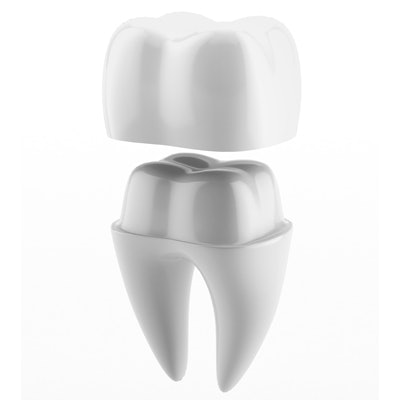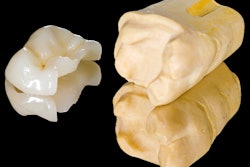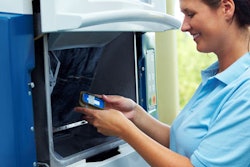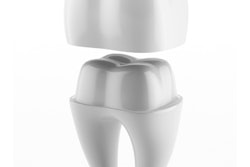
CAD/CAM-fabricated implant-supported single crowns made from lithium disilicate and paired with zirconia implants have proved to be successful in clinical studies. But how well do they hold up over the longer term and compare with other options? A new study reports results over a five-year follow-up period.
Researchers followed up annually with patients who received this treatment to determine implant survival rates and patient satisfaction, as well as how this compared with zirconia-based bilayer systems. They found that the lithium disilicate implant-supported crowns showed favorable results, although significant roughness was observed.
"CAD/CAM-fabricated implant-supported single crowns supported by zirconia implants showed promising midterm survival and success rates," the authors wrote (Clinical Implant Dentistry and Related Research, June 13, 2017). "This type of restoration can be recommended for daily clinical practice."
The researchers were led by Benedikt Christopher Spies, DDS, DMD, from the department of prosthetic dentistry at the University Medical Center Freiburg in Germany.
Implants will survive
Resin-bonded bridges and ceramic implant-supported single crowns represent less invasive, metal-free treatments for replacing a single missing tooth. The former are comparatively less invasive and less expensive and require less treatment time, but they have been shown to have higher failure rates in posterior regions than implant-supported single crowns, the authors noted.
“This type of restoration can be recommended for daily clinical practice.”
Nevertheless, all-ceramic implant-borne reconstructions have suffered from technical complications of the restorations, mainly concerning bilayer systems and chipping of the veneering ceramic. But preliminary results of a prospective study by the researchers of the current study have found that CAD/CAM-fabricated, monolithic, implant-supported single crowns made from a lithium disilicate ceramic supported by zirconia implants are significantly more successful than bilayer systems, regardless of the layering technique and veneering ceramic.
The researchers conducted the new study to confirm these findings and report longer-term, five-year results for these implants. The study included 24 patients who had lost a single tooth. They were required to be between the ages of 18 and 70, systemically healthy, and in need of an implant-supported single-tooth restoration and also have sufficient bone volume to allow placement of implants with a diameter of 3 mm to 5 mm and a length of at least 9 mm without major augmentation procedures.
Implantation in the study participants involved the following steps:
- A midcrestal incision with or without vertical relieving incisions followed by elevation of a full-thickness mucoperiosteal flap
- After pilot drilling, enlargement of osteotomies with drills fabricated out of the same zirconia composite (alumina-toughened zirconia) used for the production of the implants
- Insertion of one-piece zirconia implants (Ziraldent FR1, Metoxit)
- Immediate temporization of implants by relining prefabricated eggshell provisional crowns
- Impressions taken after a healing period of at least six weeks
- Restorations designed using digitized casts (inEos/Cerec inLab, Dentsply Sirona) and grinded out of lithium disilicate blanks (IPS e.max CAD LT, Ivoclar Vivadent)
- After sufficient fitting on stone casts and final crystallization/glaze firing, adhesive cementing (Multilink Automix, Ivoclar Vivadent) of the monolithic restorations (4 incisors, 10 premolars, 10 molars) to implant abutments
- Control and adjustment of central and dynamic occlusion to avoid excessive forces
All implant-supported single crowns were opposed by fixed reconstructions (which were all single teeth except for one bridge) or natural teeth.
Follow-up visits were scheduled with all patients annually from one to five years after implant placement. These visits included clinical and radiographic evaluation of the implants and surrounding tissues. Investigators took impressions and clinical photographs of the crowns and neighboring teeth. They evaluated stone casts using a light microscope and compared them with surface topography of impressions taken at prosthetic delivery to detect any minor chip-off fractures.
The investigators examined all restorations for ceramic fracture, occlusal roughness, marginal integrity, contour deficiencies, aesthetic appearance, and color deviations. They rated them A if they had no problems and B if there were minor problems. This included cases in which intraoral polishing was done for a minor chipping fracture or an area of roughness with a maximum diameter of less than 2 mm. A rating of C indicated major complications, and D indicated that the reconstruction had to be removed. Ratings of A and B that sufficiently satisfied the patient's needs were considered successful, while C ratings indicated nonsuccess but survival, and D ratings meant failure.
Patients rated their perceptions of function (eating), aesthetics, sense, speech, and self-esteem using a visual analog scale prior to treatment and at follow-up visits.
Implant delivery occurred an average of 184 ± 70 days after implant surgery. All patients were seen at the one-year follow-up and 22 patients at the five-year follow-up visit. The mean observation time was 61.1 ± 2.8 months after implant surgery and 55.2 ± 4.2 months after insertion of the final implant-supported single crown.
All implants survived to the five-year mark. Two implants showed major occlusal roughness, with this significantly increasing over time and being the only factor with a significant change observed. Repolishing was performed for all implant-supported single crowns with at least minor roughness observed.
Minor chipping occurred with one crown, and two underwent marginal discoloration. The researchers found no statistically significant changes in marginal integrity, contour of reconstructions, and aesthetics compared with baseline scores at insertion. Additionally, they found no statistically significant differences for success rates related to gender or implant location.
| 5-year follow-up results for 22 patients | ||
| Category | Rating A | Rating B |
| Ceramic fracture | 21 | 1 |
| Occlusal roughness | 7 | 14 |
| Marginal integrity | 20 | 2 |
| Contour | 6 | 16 |
| Aesthetics | 5 | 17 |
| Marginal discoloration | 20 | 2 |
Compared with baseline scores before insertion, visual analog scores for function (eating), aesthetic/appearance, sense, and speech improved significantly and remained stable until the end of the follow-up period, although self-esteem did not change significantly.
| 5-year follow-up results on patient-reported ratings on 0-100 visual analog scale |
||||
| Function (eating) | Aesthetic/appearance | Sense | Speech | Self-esteem |
| 98.0* | 90.3* | 93.1* | 98.2* | 96.1 |
"The present investigation revealed (1) no need for replacements, (2) a low technical complication rate of one minor chipping and two major occlusal roughnesses resulting in 92% of the implant-supported single crowns rated as successful, and (3) a high and long-lasting satisfaction of patient's demands," the authors wrote. "However, incidence of minor occlusal roughness was high and statistically significant."
They noted that these and the other limited data on the clinical outcomes of cemented implant-supported single crowns made from lithium discilicate ceramics, which report high survival rates, encourage the further evaluation of this type of ceramics for CAD/CAM fabrication for this application.
Slight mismatch
At final prosthesis delivery, 15 of the 24 (62.5%) crowns had a slight mismatch in color of less than one Vita shade, mostly due to a mismatch with the color gradient of adjacent natural teeth. This could have been changed by superficial shading, but the majority of patients opted to have these B-rated crowns inserted. The mean visual analog score of 90.3 for aesthetics and appearance reflects that, the authors wrote.
Additionally, the incidence of roughness was another shortcoming with this crown-implant system.
"Incidence of roughness suggests the need of periodic recall sessions," the authors concluded. "However, technical complication rates were significantly lower as when compared to zirconia-based bilayer systems in comparable setups."
Study disclosure
The study was supported by Ivoclar Vivadent.



















